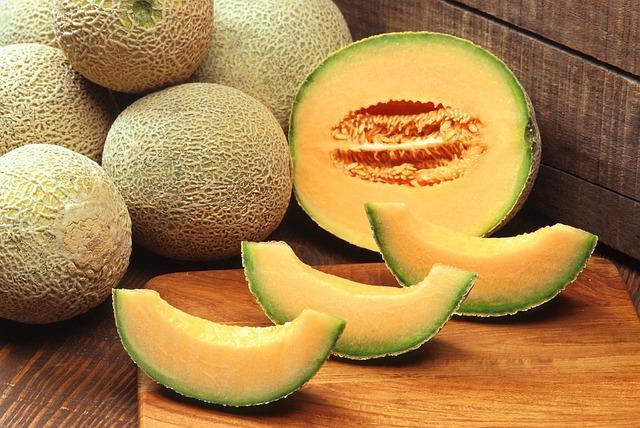Planting melon facts
- Hardiness: Very tender warm-season annual. Frost will injure top growth; needs warm weather to grow.
- Planting: Direct sow the seeds in a sunny, well-drained area when all danger of frost is past and the soil is warm. For earlier fruit, start seeds indoors 3 weeks prior to transplanting. Melons grown from transplants can be harvested as much as four weeks earlier than melons grown directly from seed. Full sun requires direct light at least 6 hours/day; prefers 8 - 10 hours/day.
- Days to maturity: 80 - 100 days from transplanting.
- Spacing: Muskmelon (Cantaloupe) 24" in-rows x 60"- 72" between rows; watermelon 3'-4' in rows x 6'-7' between rows, depending on cultivar. Or plant 2-3 plants in hills spaced 6- 8 ft. apart.
- Fertilizer needs: Medium requirement for nutrients, either from soil organic matter or fertilizers. Incorporate compost prior to planting. Use a starter fertilizer for transplants. Side-dressing with excessive nitrogen may lower yield and quality. Late-maturing varieties may need additional fertilizer at fruit set. Refer to Fertilizing Vegetables for details.
- Approximate yield: 2 - 4 fruit per plant depending on type and cultivar.
Muskmelon, cantaloupe, and watermelon problems
Air pollution
Anthracnose
Bacterial wilt
Cucumber beetle
Downy mildew
Low yields-undersized fruits
Pollination problems
Powdery mildew
Squash vine borer
Cantaloupe (muskmelon)
- Melons grown in Maryland, except watermelon, are in the species Cucumis melo. Most of the “cantaloupes” grown in Maryland are actually muskmelons- C. melo (Reticulatus Group). These melons are netted (rough skin) and usually slip from their stems when ripe.
- The true cantaloupes (e.g., 'Charentais') are in the Cantalupensis Group. They are usually smaller than muskmelons, are not netted, and do not slip from their stems when ripe.
- True cantaloupes are not typically grown in Maryland gardens.
- Honeydew, Casaba, and Crenshaw melons are in yet another group within Cucumis melo.
Watermelon
- Watermelon (Citrullus lanatus) vines range in length from 6 ft. (bush types) to 20 ft. Although fun to grow, they take up a large amount of space making a small garden much less productive. It is difficult for gardeners to grow high-quality watermelons like area farmers.
- Seedless watermelons are genetic triploids (three sets of chromosomes) and require a second diploid (typical two sets of chromosomes) variety (seeded) planted nearby to set fruit. They have lower germination rates and seedling vigor and require more careful management.
- The fruit is called a pepo, a berry that has a thick rind and fleshy center. Like other members of the Cucurbitaceae family, the ovaries (undeveloped fruits) form directly below (inferior to) the female flowers.
- Loosely considered a type of melon, the fruit has a smooth exterior rind and a juicy, sweet interior flesh (usually pink, but sometimes orange, yellow, or red; white or green if not ripe).
- Watermelon contains about 6% sugar and 92% water by weight. As with many other fruits, it is a source of vitamin C.
- Rinds are also edible and contain many nutrients. They can be stir-fried, stewed, or, more often, pickled.
Growing and caring of cantaloupe, muskmelons, and watermelons
- Melons are warm-season crops requiring a long growing season. Most cultivars are not well suited to small gardens because of the large space requirement.
- Muskmelons and watermelons grown on black plastic mulch or black landscape fabric will produce larger and earlier harvests. If possible, run a soaker hose or drip irrigation line under the plastic or fabric.
- Lift and move vines so they grow in one or two directions. This saves space and keeps your garden orderly.
- To produce watermelons, pollen must be carried by bees from a male flower to a female flower (the one with the tiny swollen melon), on the same plant or on different plants. Other melon plants mostly have separate male flowers and perfect flowers (have male and female organs) on the same plant and are pollinated similarly to watermelon.
- Poor melon set is common during rainy weather when bees are inactive. Avoid using pesticides, especially during bloom period.
- Growing plants on a trellis allows closer spacing but each trellised melon (using cultivars that produce small fruit) must be supported by a sling made of a material that dries quickly to prevent rot.
- Place cardboard or straw under developing fruits to prevent rot.
- Weeding – Although vigorous melon vines can shade out weeds it's critical to control weeds early. A thick organic mulch will limit weed growth and help protect fruits from rot diseases.
- Watering – Keep plants well-watered during establishment and fruit expansion. Unless a prolonged dry spell strikes, stop watering when the fruits begin to ripen. This will improve flavor and reduce the risk of fruit splitting.
Harvesting muskmelon and watermelon
- Muskmelons are at their peak for flavor when harvested at “full slip,” which is when the stem separates easily at the point of attachment. Handle fruits gently.
- Other types of melons, like honeydew and Crenshaw, are cut off the vine after they turn completely yellow.
- Muskmelon continues to ripen after harvest, unlike watermelon.
- All melons will rot if left on the ground too long.
- For watermelons, the best indicators are a yellowish (not white) color on the underside where the fruit touches the ground and a dead tendril or curl near the point where the fruit is attached to the vine. You may also thump the fruit, listening for the dull sound of ripe fruit, rather than a more metallic sound.
Storage and preservation
- Will keep for 5 to 18 days in cool (32° to 50°F), moist (90% Relative Humidity) conditions. Refrigerate and cover once a melon is cut.
